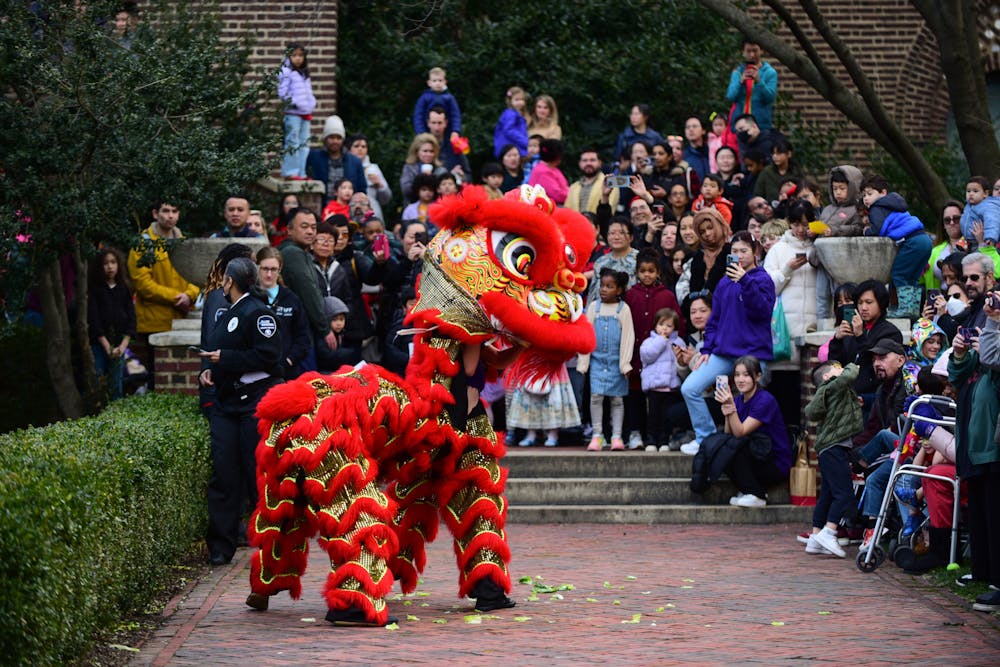
As Penn Lions enters a busy season of Lunar New Year performances, members reflected on the cultural significance of lion dances in a college setting and how the group has evolved over the years.
Penn Lions is set to perform around 26 dances on campus and across Philadelphia this month in celebration of Lunar New Year. Current members, as well as the group’s founder, discussed how Penn Lions has both preserved tradition and implemented new artistic style since the troupe’s inception in 2007.
Penn Lions practices the Hok San style of the lion dance, a traditional art form that originated in Southern China. The club recently performed at events hosted by the Pan Asian Graduate Student Association, the Weitzman School of Design, and Penn Dining.
The dance often involves a pair of performers in lion costumes telling a story of overcoming an obstacle to herald good fortune in the coming year, accompanied by percussion and props. The lion dance is primarily based in martial arts, according to College senior and Penn Lions Director Sophia Liston.
"In a more traditional setting where you learn lion dance through martial arts school...you would learn martial arts before you even touch a lion,” she said.
Liston said that many new members start with little formal experience.
“They learned foundational movements first, and then have started to build up a little bit of strength just by doing stances, doing head work, and footwork,” Liston said.
Once the members gain some strength, they learn to stack, one of the more acrobatic and dangerous moves in lion dancing. Stacking requires the back partner to lift the front partner into the air, which is a classic part of the routine.
Penn Lions formed in 2007 as Penn's first lion dance troupe. 2010 graduate and founding member Henry Chow, who had a childhood love for the art form, said that he wanted to introduce appreciation for the cultural significance of lion dances at Penn.
“Our goal was to make this thing survive and last forever,” Chow said. “And it started off by doing everything the right way and establishing really deep roots, foundations, and traditions.”
The first performance of what would become the Penn Lions featured a boom box recording rather than live percussion, with the dancers recalling bits of lion dancing they had learned in childhood Chinese schools. Chow highlighted that in addition to social benefits and mentorship, participating in the club also imparted the sense of creating a legacy.
“It was really fulfilling because it touched upon our cultural roots,” Chow said. “It made us feel like we were doing something that was important personally and could also leave a mark on the University.”
He said that he was proud of how Penn Lions has grown since its founding, adding that he hopes for future boards to understand the troupe’s core mission — which is to learn, demonstrate, and teach lion dance.
Given that the dance is fully student-taught, the board passes down advice and teaching tips to future club leaders. Retiring members supervise new board members as they learn to fulfill their roles. The club also maintains contact with alumni.
“[Around] Homecoming, we tend to have a practice [where] we invite alumni back to give some input and some of their advice,” Nursing sophomore and VP Internal Trinity Shiu said.
A lion’s life span is anywhere between one to five years. The first three lions — OJ, Grandma, and Grandpa — have long since been retired, but current club members are still familiar with their names. Liston said that one lion, named Crazy Eyes, was in use for eight years before retiring last year.
Each year, the club also adds their unique variation to the lion dance tradition while still staying true to the Hok San style. Directors adjust the choreography by taking inspiration from footage of professional dancers and drawing on existing symbolism, such as the use of a river obstacle to represent achieving enlightenment.
The dancers also add their own expression based on different sections of the performances and the lions’ personalities. Liston said that dancers often interact with onlookers in a playful way.
Engineering junior and Co-VP External Brianna Leung observed that lion dance troupes rely on either self-taught skills or generational knowledge. She described the process of incorporating that knowledge into performances as “ever-dynamic.”
“Even as recently as this year, we've been changing some aspects of our style, or how we signal to each other or how we stand,” Leung said. “We dance completely differently now. But I think that's really cool. It's like rings on a tree.”
The Daily Pennsylvanian is an independent, student-run newspaper. Please consider making a donation to support the coverage that shapes the University. Your generosity ensures a future of strong journalism at Penn.
Donate




